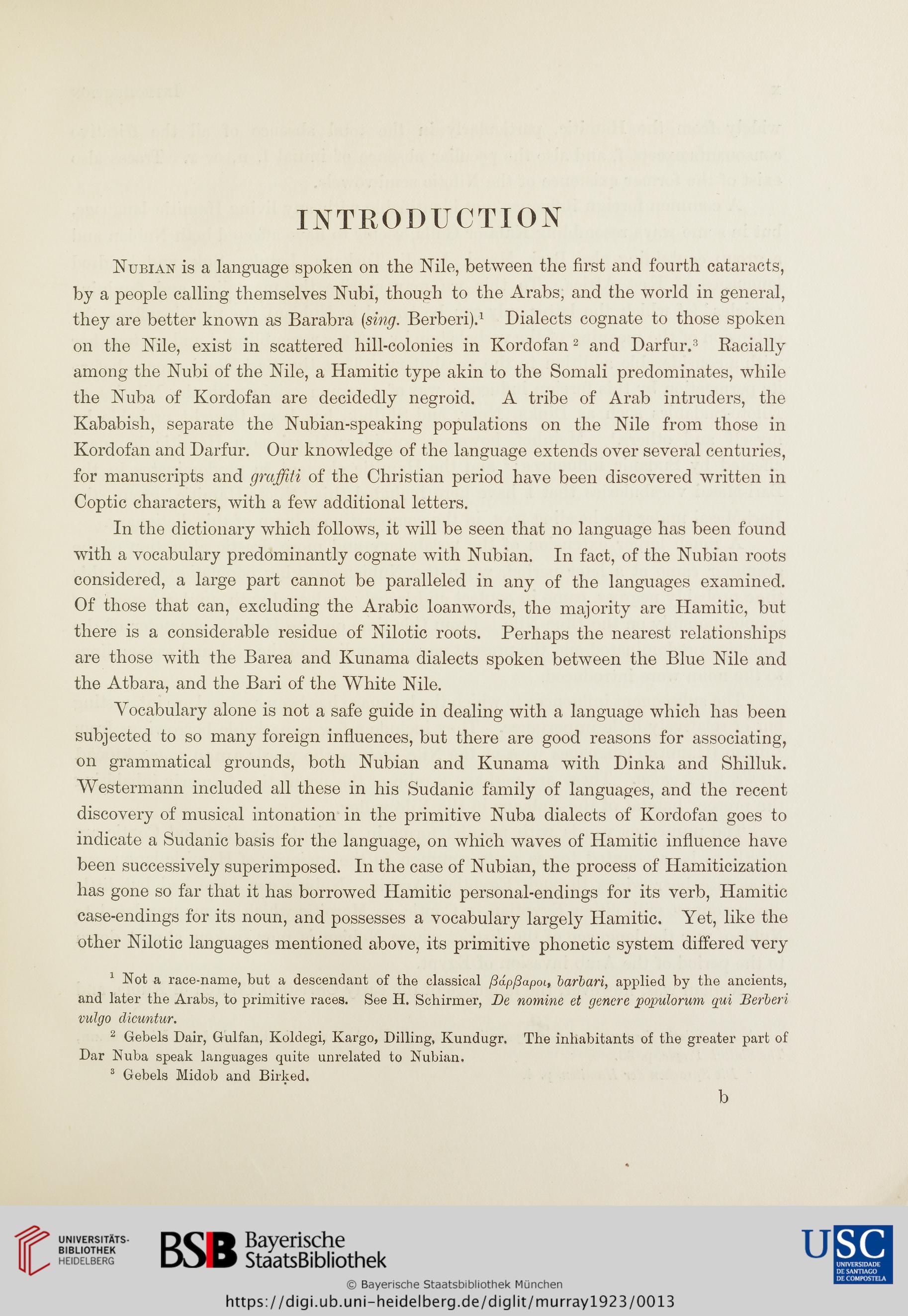INTRODUCTION
Nubian is a language spoken on the Nile, between the first and fourth cataracts,
by a people calling themselves Nubi, though to the Arabs, and the world in general,
they are better known as Barabra (sing. Berberi).1 Dialects cognate to those spoken
on the Nile, exist in scattered hill-colonies in Kordofan2 and Darfur.3 Racially
among the Nubi of the Nile, a Hamitic type akin to the Somali predominates, while
the Nuba of Kordofan are decidedly negroid. A tribe of Arab intruders, the
Kababish, separate the Nubian-speaking populations on the Nile from those in
Kordofan and Darfur. Our knowledge of the language extends over several centuries,
for manuscripts and graffiti of the Christian period have been discovered written in
Coptic characters, with a few additional letters.
In the dictionary which follows, it will be seen that no language has been found
with a vocabulary predominantly cognate with Nubian. In fact, of the Nubian roots
considered, a large part cannot be paralleled in any of the languages examined.
Of those that can, excluding the Arabic loanwords, the majority are Hamitic, but
there is a considerable residue of Nilotic roots. Perhaps the nearest relationships
are those with the Barea and Kunama dialects spoken between the Blue Nile and
the Atbara, and the Bari of the White Nile.
Vocabulary alone is not a safe guide in dealing with a language which has been
subjected to so many foreign influences, but there are good reasons for associating,
on grammatical grounds, both Nubian and Kunama with Dinka and Shilluk.
Westermann included all these in his Sudanic family of languages, and the recent
discovery of musical intonation in the primitive Nuba dialects of Kordofan goes to
indicate a Sudanic basis for the language, on which waves of Hamitic influence have
been successively superimposed. In the case of Nubian, the process of Hamiticization
has gone so far that it has borrowed Hamitic personal-endings for its verb, Hamitic
case-endings for its noun, and possesses a vocabulary largely Hamitic. Yet, like the
other Nilotic languages mentioned above, its primitive phonetic system differed very
1 Not a race-name, but a descendant of the classical [3d.pt3a.pot, barbari, applied by the ancients,
and later the Arabs, to primitive races. See H. Schirmer, De nomine et genere populorum qui Berberi
vulgo dicuntur.
2 Gebels Dair, Gulfan, Koldegi, Kargo, Dilling, Kundugr. The inhabitants of the greater part of
Dar Nuba speak languages quite unrelated to Nubian.
3 Gebels Midob and Bilked.
b
Nubian is a language spoken on the Nile, between the first and fourth cataracts,
by a people calling themselves Nubi, though to the Arabs, and the world in general,
they are better known as Barabra (sing. Berberi).1 Dialects cognate to those spoken
on the Nile, exist in scattered hill-colonies in Kordofan2 and Darfur.3 Racially
among the Nubi of the Nile, a Hamitic type akin to the Somali predominates, while
the Nuba of Kordofan are decidedly negroid. A tribe of Arab intruders, the
Kababish, separate the Nubian-speaking populations on the Nile from those in
Kordofan and Darfur. Our knowledge of the language extends over several centuries,
for manuscripts and graffiti of the Christian period have been discovered written in
Coptic characters, with a few additional letters.
In the dictionary which follows, it will be seen that no language has been found
with a vocabulary predominantly cognate with Nubian. In fact, of the Nubian roots
considered, a large part cannot be paralleled in any of the languages examined.
Of those that can, excluding the Arabic loanwords, the majority are Hamitic, but
there is a considerable residue of Nilotic roots. Perhaps the nearest relationships
are those with the Barea and Kunama dialects spoken between the Blue Nile and
the Atbara, and the Bari of the White Nile.
Vocabulary alone is not a safe guide in dealing with a language which has been
subjected to so many foreign influences, but there are good reasons for associating,
on grammatical grounds, both Nubian and Kunama with Dinka and Shilluk.
Westermann included all these in his Sudanic family of languages, and the recent
discovery of musical intonation in the primitive Nuba dialects of Kordofan goes to
indicate a Sudanic basis for the language, on which waves of Hamitic influence have
been successively superimposed. In the case of Nubian, the process of Hamiticization
has gone so far that it has borrowed Hamitic personal-endings for its verb, Hamitic
case-endings for its noun, and possesses a vocabulary largely Hamitic. Yet, like the
other Nilotic languages mentioned above, its primitive phonetic system differed very
1 Not a race-name, but a descendant of the classical [3d.pt3a.pot, barbari, applied by the ancients,
and later the Arabs, to primitive races. See H. Schirmer, De nomine et genere populorum qui Berberi
vulgo dicuntur.
2 Gebels Dair, Gulfan, Koldegi, Kargo, Dilling, Kundugr. The inhabitants of the greater part of
Dar Nuba speak languages quite unrelated to Nubian.
3 Gebels Midob and Bilked.
b




